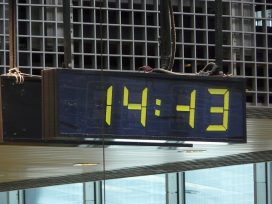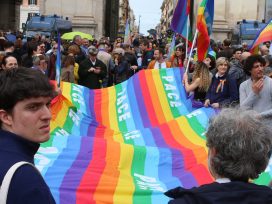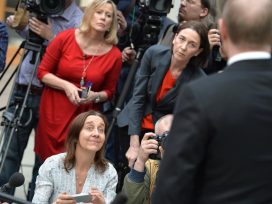Russia: From stalemate to equilibrium?
The interaction between the legal-rational and neo-patrimonial state provides the key to interpreting developments in post-communist Russia, argues Richard Sakwa. This tension precludes assigning Russia simply to the camp of authoritarian states, but it also means that Russia’s democracy is flawed.
When does a transition end? Obviously, this is an impossible question to answer, since processes of political and social change are enduring. Nevertheless, there is a special quality to societies engaged in periods of accelerated change, and the literature and methodologies of the field of comparative democratisation can provide a guide to understanding what is going on, as long as we are discriminating when applying concepts and theoretical constructs devised to understand one region to another, with very different characteristics. It is for this reason that I identify two types of transitology. The first is typological (often accompanied by elements of teleology), whereas the second is more genealogical, and rooted in the real processes underway in a particular society.1 As far as Russia is concerned, the process of intense political change is far from over, and a number of domestic and foreign policy challenges remain to be resolved. These are not so much policy issues as fundamental epistemological choices, and this is why Russia remains “transitional”.
Stalemate and equilibrium
The country finds itself in a situation of stalemate, where social and political interests and epistemic communities are locked in balance, allowing the “Bonapartist” political regime extreme freedom of action. The power system (vlast’), indeed, draws its authority by balancing between factions and the two pillars of the dual state, the administrative regime and the constitutional state. This is a classic “stability regime”, permanently engaged in the manual manipulation of political processes to ensure pre-eminence. In this context, the transition will end when there is a shift from the stalemate of the stability regime to equilibrium, based on a more or less organic balance of interests and ideas that reflects the dominant consensus in society. The idea of equilibrium is drawn from neo-classical economics and suggests a “normalisation” in a situation after a period of turbulence. It is precisely this sort of equilibrium that suggests that a transition is over and society has achieved a degree of normality, until the next period of breakdown and transition to a new equilibrium.
For over twenty years Russia has been engaged in a classic period of reform and catch-up modernisation. Several political imperatives, geopolitical orientations and developmental paths operate at the same time, ensuring an extremely high degree of epistemic pluralism. Contrasting world views of Russia’s identity and destiny are locked in tension, creating systemic and developmental stalemate. Equally, there are numerous recipes to overcome this stalemate. This lack of consensus over a convincing vision of the future and the means to attain it was one of the factors provoking the sharp reaction following the announcement of the “castling” move on 24 September 2011. Even many of his erstwhile supporters looked at six more years of Putinite stability with dread. Vladimir Putin’s personalistic virtuoso performance as leader, however, only reflected the deeper systemic stalemate. Intense activity without movement was indeed reminiscent of the period of stagnation and the stability regime of the late Brezhnev years, and reflected the stalemate of the Soviet system in its terminal phase.
The characteristic feature of modernity is the emergence of autonomous civic actors accompanied by attempts of the state to manage various transformative projects that entail the management and reordering of society. In this respect Putin reflected the larger contradiction within modernity. It is a contradiction exacerbated in Russia by the clear tension between liberal democratic aspirations and the state’s inability to act as a coherent vessel in which these aspirations could be fulfilled. The state is challenged by an administrative system that it can barely constrain, and power is exercised by a technocratic but often corrupt elite that sees its own perpetuation as synonymous with stability, security and development. Only the evolutionary but rapid consolidation of the constitutional state can avert the onset of a renewed era of revolutionary upheavals. There is a natural cycle to leadership, and Putin’s return to power for a third term raised fears that the country was entering another terminal phase.
Duality
The contrast between an administrative and a constitutional state provides the key to interpreting developments in post-communist Russia.2 The fundamental legitimacy of the regime is derived from being embedded in a constitutional order to which it constantly proclaims its allegiance. However, notably in the Yukos affair, elements of the prerogative state have emerged (Verwaltungsstaat). Thus the interaction between the constitutional (legal-rational) and administrative (neo-patrimonial) state in Russia has become the defining feature of the current political order. This dynamic tension precludes assigning Russia simply to the camp of authoritarian states in an essentialist manner, but it also means that Russia’s democracy is flawed, above all because of abuses in the rule of law and the lack of political competition conducted on a level playing field. It is for this reason that as Russia entered the 2011/12 electoral cycle there were demands, including from leading officials (notably finance minister Alexei Kudrin), for the elections to be held in a free and fair manner. The rule of law in Russia remains fragile and is susceptible to manipulation by the political authorities, but neither has a fully-fledged prerogative state emerged. Thus Russia remains trapped in the grey area between an administrative and a genuine constitutional state. This is what endows Russia with the features of systemic stalemate.
Contemporary Russia is more than just a hybrid polity, combining democratic institutions with authoritarian practices: it is a dynamic system in which the principles sustaining the new order remain in fundamental tension. In this system power derives from the networks engaged in informal practices in permanent struggle with the constraints imposed by the formal constitutional order. Power is thus both formless and contained. The field of comparative democratisation is too often engaged in symbolic labelling, sliding into categorical labelling that describes Russia as an authoritarian system tout court, and with subsequent discussion built on this premise (the typological approach mentioned earlier). Instead, I argue that a more dynamic perspective based on a genealogical approach is more fruitful. Its starting point is that Russia is a weak democracy with authoritarian features, rather than an authoritarian system with some relics of democracy. This may appear to be a controversial position, especially given the current demonization of Putin, yet it reflects the continued open-endedness of the historical situation.
Two types of domination, or rule, identified by Max Weber as “patrimonial” and “legal-rational”, generate two distinctive political orders, which in turn have given rise to the “dual state”. The neo-patrimonial elements generate systemic insecurity about which rules will apply at any particular time and thus actors have recourse to a range of informal behaviours to reduce risk, but this only generates further systemic insecurity and undermines the consolidation of the formal constitutional rule-bound political order. The arbitrary application of rules, and constant changes to the regulatory framework regulating the conduct of elections and party development, gives a very short time horizon to individuals and to the behaviour of organisations. This has not yet been trumped by the emergence of a system-forming party with a longer time frame.3 Formal and informal rules operate at the same time, reproducing dualism at all levels and allowing actors to operate elements of either, but undermining the inherent internal logic of both. Actors devise numerous strategies to overcome insecurity, above all by operating in a “dual” way: by employing both the formal and informal arenas. This reproduces systematic insecurity, and reinforces the insecurity that is endemic to the operation of the system as a whole. The combination of legal-rational behaviour and patrimonial forms of domination is typical for neo-patrimonial systems, but the application of the dual state model to describe this behaviour gives substance to a more dynamic model, as well as to the contradictory nature of this form of rule. It is also able to identify the dynamics of resistance to that rule, based strengthening the constitutional state and pushing back against the arbitrariness and corruption of the administrative regime.
The constitutional state is based pre-eminently on the formal order of institutions, and thus its practices are unlike the factionalised politics of the administrative regime. Its adherents are found in legal-constitutional structures, among the liberal intelligentsia and those who have advanced into the elite up the electoral ladder. The latter route for independent politicians has, however, been increasingly blocked by the suffocating regulations imposed on the electoral process by the administrative regime. By definition, the defenders of constitutionalism and the rule of law appeal to openness and due process, although that does not preclude some factional fighting of their own. The goal of universal law has been proclaimed by all leaders since Mikhail Gorbachev, and both Putin and Dmitry Medvedev, with their legal background, have proclaimed the supremacy of law (gospodstvo zakona), although the achievement falls far short of the ambition.
Russia has a dominant power system exercised by a political regime that draws its strength from both wings of the dual state. This vlast’ prevails over a dominant party system, in which political conflicts, executive selection and policy formulation would be resolved by an autonomous party formation. Instead, although parties are the main actors in parliamentary elections, they are at best accessories to processes taking place within the regime. This applies as much to United Russia (Edinaya Rossiya, UR) as to other parties, hence its role as a “dominant party” is limited. This model of vlast’ is seen by some as the centrepiece of a whole sistema of reciprocal dependencies and supports.4 I take a rather more structural approach, in which informal relations are constrained by the formal world of institutions, with institutions here broadly defined to encompass the para-constitutionalism that is the trademark feature of Putinism, accompanied by the para-politics which bypasses but does not repudiate formal relations. The dominant power system, moreover, has always associated itself with a developmental programme firmly linked to a transitional agenda of building a competitive economy integrated into the international economy, even though the developmental state and its associated industrial strategy seeks to shape the terms on which Russia becomes part of the international division of labour.
Post-communist Russia has been in a permanent state of exception, exercised not through constitutional provisions of some sort defining a state of emergency (as in Hosni Mubarak’s Egypt to his fall in February 2011) but through an informal and undeclared derogation from constitutional principles. This is exercised by the administrative regime, which in the long-term undermines the viability of constitutionalism as a whole. Elsewhere, notably in Malaysia and Singapore, regimes of exception have been unable to return to a condition of constitutional normality, but the problems associated with exceptional rule have been mitigated by the delivery of significant public goods, notably security and economic growth. In Russia, however, the state of exception has not become the norm and coexists with the routine exercise of law, and thus the situation remains liminal and open-ended. It is also stalemated, hence allowing the emergence of a power system standing above the two wings of the dual state.
Stalemate
The system at present is locked in stalemate. This was already the case in the early 1990s, on a different plane, as a result of the conflict between parliament and the presidency and provoked the violent dénouement of October 1993. The outcome was not simply a “winner takes all” situation, since there remained limits on presidential power as new actors emerged to balance the executive. Boris Yeltsin was certainly not able to have his way in a Duma dominated by an opposition majority. Once again, Putin resolved the problem by creating a loyal pro-regime dominant party, but at the cost of eroding political pluralism and the quality of governance overall. Political opposition as a political practice was marginalised, allowing a bureaucratic managerial style to predominate. In the absence of an open public sphere and accessible mass media, corruption proliferated. A no less deleterious consequence of the erosion of open politics was the growth of intra-regime factionalism. The stalemate continues, but it now takes a number of distinctive forms:
Political
The first is the clash of two political orders, the forms of order associated with the constitutional state, on the one hand, and, on the other, the neo-patrimonial features of the administrative regime. Elements of the two are present in most countries, but in Russia the combination constitutes a distinctive order of its own. The two types of rules interact on a daily basis, leaving observers to clutch at every small sign as evidence of the predominance of one or the other. The apogee of systemic stalemate was reached in the tensions apparent in the “tandem” form of rule in the final period of Medvedev’s presidency, as it became clear that Putin, as prime minister, was considering whether to assume the presidency (as allowed by the constitution) in 2012.
Two political systems operate in parallel. On the one hand, there is the system of open public politics, with all of the relevant institutions described in the constitution and conducted with pedantic regulation in formal terms. At this level parties are formed, elections fought and parliamentary politics conducted. However, at another level a second para-political world exists based on informal groups, factions, and operating within the framework of the inner court of the presidency. This Byzantine level never openly challenges the leader, but seeks to influence the decisions of the supreme ruler. This second level is more than simply “virtual” politics, the attempt to manipulate public opinion and shape electoral outcomes through the pure exercise of manipulative techniques, although by permitting the para-politics of the second system Putin ensured that the formal side of political life was liable to become little more than “show-politics”, a spectacle to satisfy the formal demands of the system and the international community, but lacking the efficacy that, however limited, is one of the characteristics of modern democracies.5 By seeking to reduce the inevitable contradictions that accompany public politics into a matter of technocratic management, Putin inevitably exacerbated the contradictions between the groups within the regime itself. Putin placed a high value on civil peace, and thus opposed a return to the antagonist politics that was typical of the 1990s, but this reinforced the pseudo politics typical of court systems. The suffocation of public politics intensified factional processes within the regime and corruption in society as a whole.
Sociological and economic
Two great class forces are locked in stalemate in contemporary Russia. The first is the neo-Soviet bureaucracy, a great mass of officialdom entrenched in the ministries, the security apparatus and the military. This is accompanied by pensioners, which consistently provides the Communist Party of the Russian Federation (CPRF) with its vote, and provides the bedrock of Putin’s support. This represents a type of “sociological communism”, by analogy with what Paul Preston has called “sociological Francoism” in post-authoritarian Spain.6 This is balanced by the emergence of sociological liberalism. In the early years of Russian post-communism the liberal forces lacked a defined social support and thus remained an idealist project relying on the state to achieve its goals of economic and political transformation. Various rent-seeking groups were able to take advantage of the impasse, and thus the idea of “partial reform equilibrium”, advanced by Hellman in the late 1990s, still has some traction.7 Khodorkovsky’s challenge in 2003 to the regime’s claim to be the manager of modernisation signalled the emergence of a new force in the land, an independent bourgeoisie; although at the time it was interpreted as a throwback to the era of oligarch power in the mid-1990s. In truth, Khodorkovsky looked backwards, in seeking to use economic power to manage the financial and tax environment in which business operated; but he also looked forward to a more pluralistic political order and an active citizenry. The Yukos affair set back the advance of the new order by nearly a decade, but the 2011/12 electoral cycle signalled the emergence of a politically conscious middle class, confident in its economic achievements and now demanding free and equal inclusion in the political order.
With a per capita income of $14,000 Russia can be classified as a rich country, yet it has at best a weak democracy.8 It appears to be caught in the classic “middle income trap”, in which the politics needs to be sorted out before the country can achieve sustained economic growth. The great majority of countries that were middle income in 1960 remained so in 2008, with only a handful having become high income economies.9 Countries engaged in catch-up growth hit an invisible ceiling, and there are only a few “break-out” states (like Japan and Korea), while some 90 countries failed to make it. The usual recipe to break out of the trap is increased productivity through innovation, and for this the political conditions have to be right.
Not only does Russia appear to have hit the economic middle income ceiling, but in political terms it has also languished for at least a decade in some sort of democratic backwater. No studies examining the relationship between economic development and democratisation have suggested an automatic determinative relationship between economic growth and political change, yet the anomalous case of Russia does need explaining. In part, the answer undoubtedly lies in the country’s troubled history, with the Soviet experience still shaping structures and practices and the “chaos” of the 1990s weighing heavily on public consciousness. The Putinite reshaping of the political system in the 2000s allowed, as we have seen, the consolidation of the administrative regime accompanied by the luxuriant growth of para-constitutional institutions and para-political practices, factionalism and corruption.
The political struggles and popular mobilisation attending the 2011/12 election indicate the growing pressure to move out of the backwater. Political liberalisation and the return to genuine constitutionalism may occur in this round of political struggle, or it may be suppressed, at high reputational and possible physical cost. One way or another, the country is looking for a way out of stalemate.
Epistemological
At least three epistemes are locked in conflict in contemporary Russia. The first is the liberal, with its representations of “normality”, “the return to Europe”, and standards of “civilisation” defined by western norms. The standard charge against the liberal episteme is that it lacks a sense of history and place; Russia emerges as a subjectless entity, with its thousand-year history denigrated, and its location on the great North European-Eurasian plain, with all of the attendant threats, downplayed. For the radical “liberal Leninists”, Russia’s history is a burden and its geopolitical assertions dangerous. The search for a “useable past” was doomed, from this perspective, to reproduce the pathologies of the past. The liberal episteme finds it difficult to critique let alone challenge the broader structures of the international system today. The liberals are associated with the “chaotic 1990s”, and since the 2000s have not been able to define an attractive political programme, although their ideas (above all in the economic sphere) remain hegemonic within Russia.
The liberal episteme is challenged by a “traditionalist” episteme. I use the word traditionalist to encompass the broadness of the phenomenon. The category includes monarchists appealing to the imperial era, arguing that some sort of return to the moral world of the pre-revolutionary epoch can contribute to the resurrection of Russia. They are balanced by a range of neo-Soviet tendencies, including dyed-in-the-wool Stalinists, socialists of various sorts, as well as those with an affective nostalgia for the comforts and certainties of the Brezhnev years. Contemporary Russian nationalism also has its roots in a traditionalist episteme, based on ideas of national integrity and a separate developmental path. The Russian Orthodox Church (ROC) expressed some of the most profound beliefs of the traditionalist episteme. These two espistemes were in evidence in the protest movement after December 2011, and in part explains the difficulties in establishing a common platform.
Between these two epistemes is the third, the “centrist” ideology espoused by the Putin regime. The Putinists were well aware of the danger posed to its power and privileges by the militancy of some sections of the traditionalist wing, even though it sought to draw on the authority of the ROC and some other “traditional” religions. Equally, the centrists had no consistent economic policy of their own, and thus pursued broadly liberal macroeconomic strategies tempered by the needs of the distributional coalitions and rent consumers on which the regime was based. The centrists also appealed to national development strategies, but failed to enunciate a consistent vision or strategy on how this could be applied. In foreign policy, the centrist regime pursued a policy of neo-revisionism: fearful of becoming the centre of a balancing coalition against the West; but equally unable to integrate into the West’s institutional and normative framework.10 Above all, in political terms, Putinite centrism espoused a technocratic managerial ethos, whose inevitable concomitant was depoliticisation. In the early years of Putin’s rule, the claim that the authorities were able to insulate themselves from the excessive influence of certain privileged “oligarchs” and other special interests was undoubtedly popular. However, by the time Putin planned to return to the presidency in 2012 this insulation claim was far less credible, especially when the regime itself was perceived to have become a “special interest” of its own, no longer able to govern in the national interest.
Conclusion
The political stalemate was part of the broader developmental crisis, in which the entrepreneurial class inspired by the liberal episteme was stymied and persecuted by officialdom and corrupt security and judicial agencies, giving rise to the mass phenomenon of “raiding”. By the time Putin re-entered the Kremlin in 2012 Russia was suffering all of the classical symptoms of blocked modernisation. Its case may not have been as severe as that in evidence in several North African and Middle Eastern states up to the “Arab Spring” in 2011, yet there were enough commonalities (above all in the practices of political exclusion and depoliticised centrism) to make the comparison valid. In Russia the stalemate was sustained by the broader sociological realities of balanced class forces accompanied by the middle income trap, reinforced by two major epistemic communities unable to gain hegemony, allowing a centrist ideology to triumph. This is not equilibrium of the sort described by neo-classical economics, but indeed a stalemate.
Democracy is seldom granted from above but requires popular pressure from below. The events attending the 2011/12 electoral cycle can be seen as a return to the agenda of 1991 – not just the consolidation of Russian statehood but the empowerment of free and equal citizenship. The regime under Yeltsin and Putin claimed a tutelary right over the people in the name of various supra-political tasks – above all creating market capitalism, the institutions of statehood and defence of the territorial integrity of the state – and this gave rise to the dual state. The protests from December 2011 represented the single greatest challenge to the entrenched powers of the administrative regime. The slogan “Russia without Putin” from this perspective was misguided. Our model suggests that a more productive focus would be the strengthening of the constitutional state, namely the rule of law, free, fair and competitive elections, a property order effectively defended against raiders and marauders, and strengthened political institutions. Only in this way can the liberal and traditional epistemes transcend the dead end of centrism, and in so doing create the basis for a new national consensus based on the defence of the constitutional state. It is certainly far from clear that a Russia without Putin could resolve these tasks better than one with a chastened Putin constrained by the revived institutions of the constitutional state and the pressure of a mature and mobilised political nation. This was the challenge facing Putin as he entered his third presidency.
Richard Sakwa, "Modernisation, Neo-Modernisation and Comparative Democratisation in Russia", in East European Politics, Vol. 28, No. 1, March 2012, pp. 43-57.
See Richard Sakwa, "The Dual State in Russia", Post-Soviet Affairs, Vol. 26, No. 3, July-September 2010, pp. 185-206.
Stephen E. Hanson, Post-Imperial Democracies: Ideology and Party Formation in Third Republic France, Weimar Germany, and Post-Soviet Russia, Basingstoke, Palgrave Macmillan, 2010.
Alena V. Ledeneva, How Russia Really Works: The Informal Practices that Shaped Post-Soviet Politics and Business, Ithaca, NY, & London, Cornell University Press, 2006.
Russia is not the only country to suffer from this syndrome, but it is clearly an extreme case. For a comparable instance, in which the comparison is drawn through the concept of "Putinism for the West", see Paolo Flores D'Arcais, "Anatomy of Berlusconismo", New Left Review, No. 68, March-April 2011, pp. 121- 140, in particular pp. 137-139.
Paul Preston, The Spanish Holocaust: Inquisition and Extermination in Twentieth-Century Spain, London, HarperPress, 2012.
Joel S. Hellman, "Winners Take All: The Politics of Partial Reform in Postcommunist Transitions", in World Politics, Vol. 50, No. 2, 1998, pp. 203-234.
"The Price of Democracy", Vedomosti, 23 June 2011, summarised by RIA Novosti, Johnson's Russia List, No. 111, 2011, Item 3.
"The Middle-Income Trap", The Economist Online, 27 March 2012. For a more detailed comparative analysis, see Harpaul Alberto Kohli and Natasha Mukherjee, "Potential Costs to Asia of the Middle Income Trap", in Global Journal of Emerging Market Economies, Vol. 3, No. 3, September 2011, pp. 291-311.
Richard Sakwa, "The Cold Peace: Russo-Western Relations as a Mimetic Cold War", in Cambridge Review of International Affairs, 2012 forthcoming.
Published 24 October 2012
Original in English
First published by Osteuropa 6-8/2012 (German version); Eurozine (English version)
Contributed by Osteuropa © Richard Sakwa / Osteuropa / Eurozine
PDF/PRINTPublished in
In collaboration with
In focal points
Newsletter
Subscribe to know what’s worth thinking about.
Related Articles
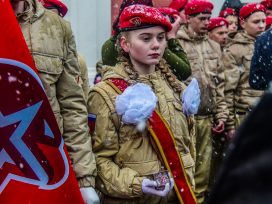
Intellectual violence
The militarization of education in Russia
Education has become another battleground in the Kremlin’s campaign to militarize the Russian public consciousness. Youth organizations, book bans, changes to school curricula – all amount to a ‘special anthropological operation’.
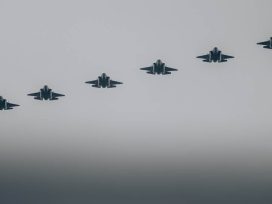
Russian drones entering Polish airspace, militarily seen as intensified provocation rather than open warfare, have nevertheless provoked costly responses – both from NATO’s air defence systems and civilian reactions to disinformation. A war correspondent’s view of what can be done technologically – for greater military efficiency and improved civil defence.

